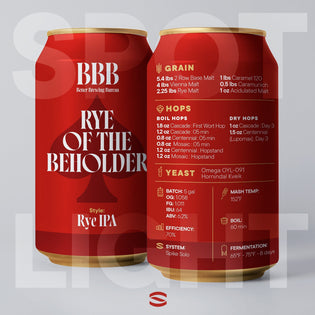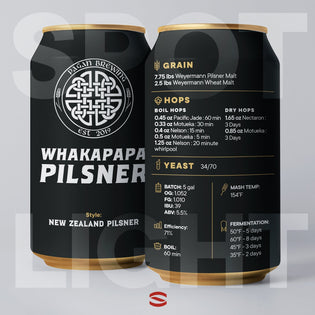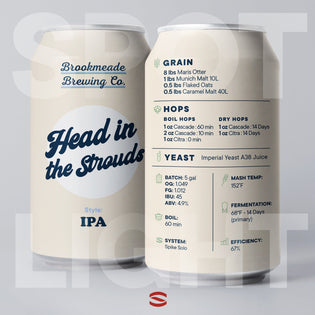
The Brewer: Joe Yeado
Joe is the prime example of a homebrewer turned pro brewer. He currently owns and operates Gathering Place Brewing in Milwaukee, WI.
“I made this recipe when I was still a homebrewer," he says. “This beer won a 1st place Blue Ribbon at the 2016 Wisconsin State Fair, 2nd place at the Nordeast Big River homebrew competition (MN), and 3rd place at the Kentucky Bluegrass Cup.”

The Beer: Vienna Lager
Lagers don't need to have super complicated grain bills and this recipe is a good example of that. Vienna malt is slightly darker than a typical base malt like Pilsner malt (4 Lovibond vs 1.8L) which gives a little fuller flavor. Munich malt is great for adding a bit more character and soft caramel flavors.

Adding Munich 10L and Munich 20L gives the beer a bit more complexity by layering up the slightly more roasted grains to add a depth of flavor and some nice bready, malty, caramel notes without being too dark or having too roasty a flavor.
The Recipe: Café Sperl Vienna Lager

INGREDIENTS
GRAIN
- 3 lbs Vienna
- 2 lbs Munich 10L
- 2 lbs Munich 20L
HOPS
- Boil hops: 0.7 oz Hallertauer Mittelfruh - 0:60 min
- Boil hops: 0.3 oz Hallertauer Mittelfruh - 0:25 min
- Boil hops: 0.3 oz Hallertauer Mittelfruh - 0:5 min
YEAST
- Wyeast 2124 Bohemian Lager

INSTRUCTIONS
BATCH SIZE: 3.5 gal
OG: 1.054
FG: 1.012
IBU: 27
ABV: 5.5%
EFFICIENCY: 79.8%
MASH TEMP:
135ºF - 0:30 min
145ºF - 0:45 min
157ºF - 0:10 min
167ºF - Mash Out
BOIL: 60 min
FERMENTATION:
50ºF - 8 days
50ºF - 34 days
SYSTEM: Trio
Pro Tips
-
Lagering - or cold conditioning - is a traditional brewing method that originated in Central Europe, namely modern Germany and the Czech Republic. These beers have a specific type of yeast that works better in colder temperatures (around 50-55 degrees) and is different from ale yeast which like warmer temperatures (68+ degrees). The cold conditioning period - anywhere from 3-6 weeks - helps create a beer that is very crisp and refreshing. The flavors are very clean without a lot of fruity flavors from the yeast. Instead, look for clean bready and malty flavors, though be sure to experiment with dry hopping to give a little more hop character than some traditional European lagers.
- Hallertauer Mittelfruh is a classic German hop from Bavaria. It's one of the four types of hops known as "Noble Hops" which have been used in brewing for hundreds of years. This hops gives earthy and floral notes with a hint of spice. It's a low alpha acid hop and is good for use later in the boil as a flavoring and aroma hop. It's a perfect hop for European lager beers.
For more articles by Joe, check out his latest blog, A Yeast Starter: The Key to Better, Boozier Beer!
Cheers,
Joe Yeado - Gathering Place Brewing
Spike Summarizes: All Things Vienna Lager
What Is a Vienna Lager?
Vienna Lager is a style of beer that originated in Vienna, Austria in the mid-19th century. It is known for its amber color, balanced malt and hop profile, and clean, crisp finish. Here, we will explore various facets of this timeless beer style.
What distinguishes Vienna Lager from other beers?
Vienna Lager stands out due to its perfect balance between malt and hops. It carries a subtle sweetness from the malt, balanced by a moderate hop bitterness.
The Vienna malt gives this beer its signature amber color, a deeper hue than its Pale Lager counterparts, yet not as dark as the Munich Dunkel.
Vienna Lager is traditionally brewed using a method called "decoction mashing", a process that helps to give the beer its distinct malt complexity.
What's the history of Vienna Lager?
Vienna Lager was first brewed by Anton Dreher in Vienna, Austria in 1841, following the development of a new kilning process that created Vienna malt.
Interestingly, after falling out of favor in Europe, Vienna Lager found a new home in Mexico in the 19th century due to Austrian immigrant brewers. This is why many commercial examples today come from Mexican breweries.
What does a Vienna Lager taste like?
Vienna Lager is characterized by a toasty malt sweetness, reminiscent of freshly baked bread.
Subtle Hop Bitterness
This maltiness is balanced by a gentle bitterness from noble hops, resulting in a beer that is flavorful yet highly drinkable.
Crisp Finish
The lagering process imparts a clean, crisp finish that leaves you wanting another sip.
How is Vienna Lager beer made?
Essential Ingredient: Vienna Malt
The primary ingredient in a Vienna Lager is Vienna malt, which gives the beer its distinctive amber color and malty flavor.
Traditionally, brewers use a method called decoction mashing. This involves boiling a portion of the mash and then adding it back to raise the temperature. This process contributes to the malt complexity of the beer.
Lagering Process
Like all lagers, Vienna Lager undergoes a process called lagering. This is a period of cold storage, typically for several weeks or months, which helps to produce a clean, crisp beer with few esters or other fermentation byproducts.
What foods go best with a Vienna Lager?
The maltiness of Vienna Lager pairs well with rich, roasted meats like pork or beef.
Given the style's popularity in Mexico, it's no surprise that it pairs well with Mexican cuisine. Think enchiladas, tacos, or even spicy foods.
The moderate flavor profile of Vienna Lager also makes it an excellent companion for mild, creamy cheeses.
Is Vienna Lager a year-round beer?
Yes, Vienna Lager can be enjoyed year-round. Its balanced flavor profile and medium body make it suitable for any season.
How strong is a typical Vienna Lager?
Vienna Lager typically has a moderate alcohol content, usually ranging from 4.5% to 5.5% ABV. This makes it a beer that's strong enough to be flavorful, but not so strong that it can't be enjoyed in multiple servings.
Are there different types of Vienna Lager beers?
The Classic Vienna Lager
The classic Vienna Lager is amber in color, malty in flavor, and balanced by a moderate hop bitterness.
The Mexican Vienna Lager
Mexican Vienna Lagers often exhibits a darker color and a more pronounced malt profile, influenced by local brewing traditions.
What's the correct temperature for serving Vienna Lager?
Vienna Lager is best served slightly chilled, typically between 46-50 degrees Fahrenheit (8-10 degrees Celsius). This temperature allows the flavors to express themselves fully, while still providing a refreshing experience.
What are some popular brands of Vienna Lager?
Austrian and Mexican Examples
Some well-known examples include Samuel Adams Boston Lager (an American interpretation), Dos Equis Amber, and Negra Modelo (both Mexican interpretations).
Local Craft Breweries
Additionally, many local craft breweries produce their own versions of Vienna Lager, offering unique takes on this classic style.
Why does Vienna Lager have a golden color?
The Role of Vienna Malt
The golden to amber color of Vienna Lager comes from the use of Vienna malt, a type of malt kilned at slightly higher temperatures than pale malt. This results in a malt that contributes both color and a unique flavor to the finished beer.
How does the brewing process affect Vienna Lager's flavor?
Decoction Mashing
Decoction mashing contributes to the malt complexity of Vienna Lager, adding depth and richness to the beer's flavor profile.
Lagering Process
The lagering process also plays a significant role. This cold storage period helps to produce a clean, crisp beer with minimal fermentation byproducts, allowing the malt and hop flavors to shine through.
Are Vienna Lagers more bitter than other beers?
While Vienna Lagers do contain a level of bitterness from hops, they are generally not considered a bitter beer style. The bitterness is typically moderate and is there to balance the malty sweetness rather than dominate the flavor profile.
Why is Vienna Lager often served in a specific type of glass?
Vienna Lager is often served in a glass with a narrow base that widens towards the top, similar to a wine glass. This design helps to concentrate the beer's aromas, enhancing the overall tasting experience.
Is Vienna Lager beer good for beginners?
Yes, Vienna Lager is a great style for beginners. Its balanced flavor profile is approachable, while still offering plenty of complexity for those new to beer tasting.
How does Austrian Vienna Lager differ from Mexican Vienna Lager?
While both styles maintain a balance between malt and hops, Mexican Vienna Lagers tend to have a more pronounced malt profile and are often slightly darker, influenced by local brewing traditions.
Where can I buy the best Vienna Lager beers?
You can find Vienna Lagers at local breweries, liquor stores, and even some supermarkets. Be sure to look out for both local craft examples and imports from Mexico and Austria.
What impacts the quality of a Vienna Lager?
Ingredient Quality
Like all beers, the quality of a Vienna Lager is largely dependent on the quality of its ingredients. High-quality Vienna malt, water, yeast, and hops are essential.
Brewing Techniques
The brewing technique also plays a crucial role. Traditional methods, such as decoction mashing and proper lagering, can significantly enhance the beer's taste and character.
Freshness
As with any beer, freshness is key. Always check the packaging dates when buying commercial beers, and drink them within their suggested freshness window.
Why is Vienna Lager named after Vienna?
The name of this beer style is a nod to its origins. Anton Dreher first brewed it in Vienna, Austria, using the newly developed Vienna malt. Therefore, it was fittingly named Vienna Lager.
Are there any variations of Vienna Lager that use unique ingredients?
While the classic Vienna Lager recipe is fairly standard, many craft breweries introduce unique ingredients or techniques for a twist on the traditional style. This could include the use of local hops or malts, aging the beer in different types of barrels, or adding unique ingredients like fruit or spices.
What kind of water is ideal for brewing Vienna Lager?
The water used to brew Vienna Lager traditionally has a moderate mineral content. This aids in enhancing the malt-forward profile of the beer, adding to its complexity.
What should I look for when tasting a Vienna Lager?
When tasting a Vienna Lager, look for a balance between malt sweetness and hop bitterness. The beer should also have some complexity, with flavors reminiscent of toasted bread, caramel, or even a hint of chocolate. The finish should be clean and crisp, typical of lagers, without any harsh or lingering aftertastes.
What are some interesting facts about Vienna Lager?
One interesting fact about Vienna Lager is that it almost disappeared in Europe, only to be revived by Mexican breweries.
Vienna Lager is said to have inspired other beer styles, such as Märzen and Oktoberfest beers.
How do I brew my own Vienna Lager?
Recipe and Process
To brew your own Vienna Lager, you'll need Vienna malt, lager yeast, and noble hops. The brewing process involves decoction mashing, a careful fermentation at lower temperatures, and a lagering period for the beer to mature and develop its characteristic clean, crisp profile.
Patience
Remember, brewing lagers requires patience. The lagering period can take several weeks, but the wait is well worth it for this beautifully balanced beer.
Are there awards for Vienna Lager beers?
Yes, Vienna Lager beers are recognized in many beer competitions, including the prestigious Great American Beer Festival and World Beer Cup. These competitions often have a specific category for Vienna Lagers, giving brewers the chance to showcase their interpretation of this classic style.





